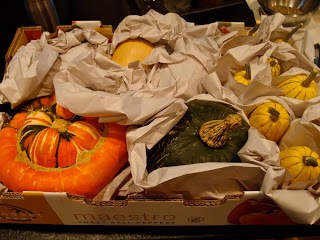To preserve many foods, you have to do a crazy water-bath dance in the heat of late August, or give over to acid-ravaged hands as you chop another ten pounds of tomatoes.
Winter squash is easier. Like Goldilocks, all it asks is to be tucked away someplace not too hot, and not too cold, but just right. Some varieties of winter squash, like Butternut, will store for dang near a year if conditions are perfect. Even the relatively short-lived Delicatas can be counted on to get to New Year’s in good shape if kept in Goldilocks conditions.
So what is good storage practice for winter squash? They will hold the longest at 55°F and 60% relative humidity. The higher the temperature, the faster the squash will lose weight and moisture from respiration. Temperatures below 50°F risk cold damage to the squash, which will shorten storage lifespan.
This is why the winter squash that were making such a nice, though unlooked for, autumn-scape at my front door have had to be moved into the garage for long-term storage. Even protected by the house, I was risking outside temperature drops that could ruin my squash.
My garage is unheated but never freezes, so it’s about as good a spot as I have for storing winter squashes. Other good storage spots might be a drafty back room or an unheated attic or basement. My neighbor stores hers just inside the front door, on a little landing area before the split-level stairs. The front door is drafty enough, and the landing far enough from any heater vent, that conditions in that one spot are pretty good!
Before I put them away on the industrial post and wire shelving out in the garage, I wipe down each of my squashes with a dilute solution of bleach to kill the fungal and mold spores that are almost certainly living on the squash’s surface. If I were measuring, I’d go with 1 part bleach to 10 parts water, but usually I just fill up my sink and glug in a bit of unscented Clorox.
I know some of my gentler readers are not fans of bleach, and if I were avoiding bleach, I’d probably do a hydrogen peroxide or full-strength white vinegar wipe down to achieve a similar mold and fungus-killing effect. After sanitizing the squash, I set them to dry on clean absorbant towels. It is very important that the squashes are dry when they go into storage, and stay that way.
Small squashes get wrapped in plain paper and stored in cardboard boxes. (Really good squashes get stored in Maker’s Mark boxes.)
I store large squashes directly on cardboard and make sure to leave good air circulation around each squash.

i always learn so much from your posts! my squash never came to fruition this year (haha get it?) – I don't know what happened. So I have nothing to store. But I'll bookmark this for next year.
Good informative post! Now, I just need to be able to grow squashes 🙂
I get the dirt off, with a damp cloth if needed. Then lightly rub with a cloth with some vinegar on it. Setting it near the woodstove "cures" the rind fast, and after a day there, I move to storage. The vinegar and the rind curing seem to be the magic for me 🙂
Altho, one year in a tiny apt. with no woodstove, and no garden, I was given two big boxes of spaghetti squash…. Those were cleaned, vinegared, and then spent the winter on top of a towel on the clothes dryer IN THE KITCHEN right next to the electric stove, as there was really no place else for them. Eating one a week, they lasted well clear into MAY ! I was astonished! lol … but happy!
Thanks for the tips. I haven't had a lot of luck with storing squash in the past (there aren't that many options in an apartment, though, especially when it comes to temperature). I'll try out some of these ideas with this year's – here's hoping!
10/10 again!Thanks Erica
Thank you for demystifying squash storage! I tend to over think everything.
Never knew about washing off the squash with vinegar or bleach. Thanks for the good tip
Thank you for any other fantastic article. Where else could anyone get that kind of info in such an ideal manner of writing? I’ve a presentation subsequent week, and I’m at the look for such info.
Trying to devour all content on storing squash! I have a fully-heated home in a climate (Eastern Washington) where we stay frozen from November till about April and finding a low-temp place to store squash is difficult. The garage freezes in winter. The basement contains our central-air heater and doesn’t have any cool spots. Getting stumped how to save my lovely, home-grown squash. The pictures of your cardboard-lined squash-filled pantry are lovely! Hoping to find a way to outsmart our modern comfort induced way of living to make produce last!
I read somewhere to rub a thin film of oil on the squash. Since some oils go rancid, I’m thinking coconut oil might be a good idea as it doesn’t go rancid at all. That must mean it has some bacterial and fungal properties, as well as not oxidizing easily. Time to experiment.